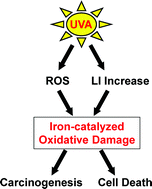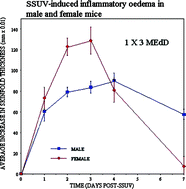This month sees the following articles in PPS that are in the top ten most accessed:-
UV wavelength-dependent DNA damage and human non-melanoma and melanoma skin cancer
Gerd P. Pfeifer and Ahmad Besaratinia
Photochem. Photobiol. Sci., 2011, Advance Article, DOI: 10.1039/C1PP05144J
Engineered photoreceptors as novel optogenetic tools
Andreas Möglich and Keith Moffat
Photochem. Photobiol. Sci., 2010, 9, 1286-1300, DOI: 10.1039/C0PP00167H, Perspective
Targeted photodynamic therapy of breast cancer cells using antibody-phthalocyanine-gold nanoparticle conjugates
Tanya Stuchinskaya, Miguel Moreno, Michael J. Cook, Dylan R. Edwards and David A. Russell
Photochem. Photobiol. Sci., 2011, 10, 822-831, DOI: 10.1039/C1PP05014A
Effects of UV radiation on aquatic ecosystems and interactions with climate change
D.-P. Häder, E. W. Helbling, C. E. Williamson and R. C. Worrest
Photochem. Photobiol. Sci., 2011, 10, 242-260, DOI: 10.1039/C0PP90036B
Human safety review of “nano” titanium dioxide and zinc oxide
Karsten Schilling, Bobbie Bradford, Dominique Castelli, Eric Dufour, J. Frank Nash, Wolfgang Pape, Stefan Schulte, Ian Tooley, Jeroen van den Bosch and Florian Schellauf
Photochem. Photobiol. Sci., 2010, 9, 495-509, DOI: 10.1039/B9PP00180H
Kinetic studies on visible-light-switchable photochromic fluorophores based on diarylethenes
Britta Seefeldt, Kai Altenhöner, Oliver Tosic, Thomas Geisler, Markus Sauer and Jochen Mattay
Photochem. Photobiol. Sci., 2011, 10, 1488-1495, DOI: 10.1039/C1PP05051F
A new photo-switchable ”on-off” host-guest system
Youngkook Kim, Young Ho Ko, Minseon Jung, Narayanan Selvapalam and Kimoon Kim
Photochem. Photobiol. Sci., 2011, 10, 1415-1419, DOI: 10.1039/C1PP05055A
CdS-sensitized TiO2 nanocorals: hydrothermal synthesis, characterization, application
S. S. Mali, S. K. Desai, D. S. Dalavi, C. A. Betty, P. N. Bhosale and P. S. Patil
Photochem. Photobiol. Sci., 2011, Advance Article, DOI: 10.1039/C1PP05084B
Supramolecular architecture of tetrathiafulvalene-bridged bis(ß-cyclodextrin) with porphyrin and its electron transfer behaviors
Jean-François Doré and Marie-Christine Chignol
Photochem. Photobiol. Sci., 2011, Advance Article, DOI: 10.1039/C1PP05186E
Tanning salons and skin cancer
Jean-François Doré and Marie-Christine Chignol
Photochem. Photobiol. Sci., 2011, Advance Article, DOI: 10.1039/C1PP05186E
Why not take a look at the articles today and blog your thoughts and comments below.
Fancy submitting an article to PPS? Then why not submit to us today or alternatively email us your suggestions.












